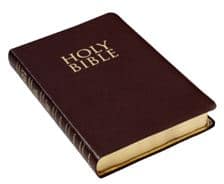The Christian Church as a whole claim that the Bible is inspired and inerrant. This means that God is the one who moved through the writers to communicate to us the words which God wanted us to hear. This inspiration, however, is not a dictation, but a movement of God’s spirit through the writer, utilizing the personality and style of the writer. Inerrancy means that all that is written in the inspired documents is without error. Now, there is a comment worth mentioning here. Inspiration and inerrancy apply to the original writings, not to the copies. In other words, it is the original writings that are without error. The copies, sadly, have copyist errors in them.
Therefore, when critics of the Bible point out apparent contradictions, what they are doing is either failing to understand the context of the passages they are examining, or they have encountered a scribal copying error. The fact is that there are indeed copyist errors on the biblical documents and they account for many alleged contradictions. Remember, it is the autographs (original writings) that are inspired and inerrant, not the copies. The copies we have now are copies of inspired documents. The copies are not themselves “inspired;” that is, they have no guarantee of being 100% textually pure. Does this then mean that we can’t trust the Bible? Not at all. The copies are so accurate that all of the biblical documents are 98.5% textually pure. The 1.5% that is in question is mainly nothing more than spelling errors and occasional word omissions like the words “the,” “but,” etc. This reduces any serious textual issues to a fraction of the 1.5%. Nevertheless, nothing affects doctrinal truths. In fact, nothing in ancient history even comes close to the accuracy of the New Testament documents. If the New Testament is disallowed, then all other documents of ancient history (Plato, Aristotle, Homer, etc.), must also be disallowed because the biblical documents are far superior in their copying accuracy than any other ancient literature in existence. See the chart below for further information on this.
Nevertheless, the following is a list of the types of errors that have crept into the Bible:
- Dittography – Writing twice what should have been written once.
- A good example would be writing “latter” instead of “later.” “Latter” means nearest the end. “Later” means after something else.
- Fission – Improperly dividing one word into two words.
- Example: “nowhere” into “now here.”
- Fusion – Combining the last letter of one word with the first letter of the next word.
- “Look it is there in the cabinet… or Look it is therein the cabinet.”
- Haplography – Writing once what should have been written twice.
- A good example would be “later” instead of “latter.” “Later” means after something else. “Latter” means nearest the end.
- Homophony – Writing a word with a different meaning for another word when both words have the exact same pronunciation.
- Meat and meet have the exact same sound but different meanings. Also, there and their and they’re are another example.
- Metathesis – An improper exchange in the order of letters.
- Instead of writing “mast,” someone writes “mats,” or “cast” and cats.”
Does this mean that the Bible we hold in our hands is not inspired? Not at all. Inspiration comes from God and when He inspired the Bible, it was perfect. Our copies of the original documents are not perfect, but they are very close to being so. The critics often mistakenly assume that even the copies are supposed to be perfect. But when I point out that God never said the copies would be perfect, they then ask how can the Bible be trusted at all? Quite simply, it is redundant in its facts and information sufficient to guarantee accuracy.
Compared to other ancient documents, the New Testament, for example, has far more textual evidence in its favor than any other ancient writing. Please consider the chart below.
| Author | When Written | Earliest Copy | Time Span | No. of Copies |
| Homer (Iliad) | 900 BC | 400 BC | 500 years | 643 |
| Ceasar (The Gallic Wars) | 100 – 44 BC | 900 AD | 1,000 years | 10 |
| Plato (Tetralogies) | 427 – 347 BC | 900 AD | 1,200 years | 7 |
| Aristotle | 384 – 322 BC | 1,100 AD | 1,400 years | 49 |
| Herodotus (History) | 480 – 425 BC | 900 AD | 1,300 years | 8 |
| Euripedes | 480 – 406 BC | 1,100 AD | 1,500 years | 9 |
| New Testament | 50 – 90 A.D. | 130 AD | 30 years | 5600 Greek mss. |
This chart was adapted from charts in Evidence that Demands a Verdict, by Josh McDowell, 1979, pages 42 and 43.
If the Bible cannot be trusted as being reliable because it has only a small percentage of copyist errors, then neither can the above documents be trusted that have far less textual support.
Therefore, we can see that the Bible is an ancient document that has withstood thousands of years of transmission with remarkable accuracy and clarity. We can trust it to be what it says it is: the word of God.
This article is also available in 中文






